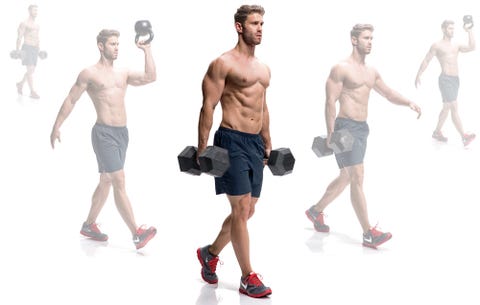
Sometimes, the simplest things in life can be the most effective. That maxim goes double for strength and conditioning, where you’ll be able to make the most out of the least technically difficult movements—as long as you’re willing to put the work in.
An exercise like loaded carries, which is as uncomplicated as a move could possibly be, is a prime example of this. All you have to do is pick up a weight and walk, and your whole body can reap the benefits.
Dan John discovered loaded carries by accident. It was 2001, and the strength coach was sidelined by injury. So he did farmer’s walks because he wanted to feel like he was still training. But when he recovered, a funny thing happened: “I looked and performed better.”
Soon John was hitting strength and discus-throwing numbers he hadn’t seen since his athlete days at Utah State. Loaded carries had a convert, and John went on to popularize them in the fitness world.
Why Loaded Carries Are So Useful

Getty Imagesheshphoto
These exercises present a serious challenge for the core muscles, according to research by Stuart McGill, Ph.D., of the University of Waterloo.
A stronger, tighter core gives your arms and legs a more powerful base for running fast, throwing hard, and performing heavy lifts. The moves also rock your lats while improving your grip strength and shoulder stability.
The benefits aren’t limited to individual muscles. “Loaded carries build work capacity,” John says, so you can do more gym work and do it better.
There are plenty of ways to build capacity, but you won’t find one that’s safer. “It’s really hard to hurt yourself when you’re walking around,” he says.
Do carries at any point in your workout—they’re especially great at the end, when you’re fatigued and your balance and coordination are hindered.
But no matter when you do them, the payoff is the same: a bigger, stronger body that’s better at anything you ask it to do.
Loaded Carry Rules to Follow
Before you pick up any weights, make sure that you know these loaded carry principles. The exercise might be simple, but that doesn’t mean that there’s no room for error. Focus on form, and you’ll be in good shape to reap the benefits.
“Pack” Your Shoulders
Straighten Your Back
Grip Hard
Step Lightly
Tuck Your Chin
Keep Your Ribs Flat
Go Heavy
Loaded Carry Variations
There are four types of carries, and each challenges your body in different ways, says exercise physiologist and competitive strongman Pat Davidson, Ph.D. Below, we offer up different variations of each. Do one every training session, making sure you’ve hit all four categories after four workouts.
Pro tip: If you look at the floor when you do exercises that challenge your balance and stability, you’re doing it all wrong.
“It’s a natural compensatory strategy, but it provides an undesirable sense of stability,” says Davidson. “It makes you shift your body weight forward, putting stress on your lower back.”
So look ahead at a distant object when you do unstable exercises, such as loaded carries, single-leg squats, deadlifts, and jumps. That, says Davidson, fixes your form and builds more strength.
Between Your Knees
Holding a heavy load between your legs works your glutes harder.
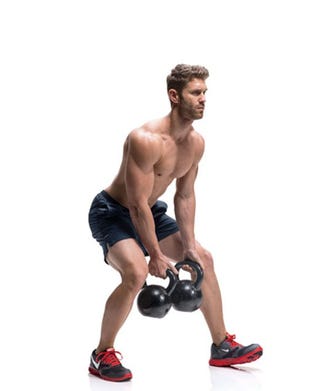
Trevor Reid
Duck Walk
Hold a kettlebell in each hand between your legs. Or cup the top end of a dumbbell and let it hang between your legs at knee height.
Side Loaded
Because you can use such heavy weights, these build insane total-body strength.
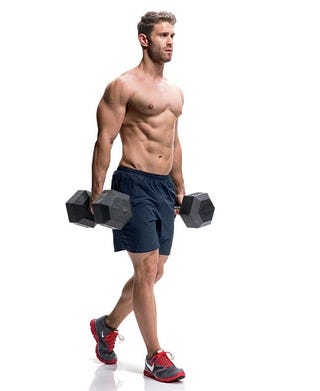
Trevor Reid
Farmer’s Walk
Hold a dumbbell, kettlebell, or barbell at each side. Grip tightly. (For loads exceeding 200 pounds, use a trap bar with weight plates.)
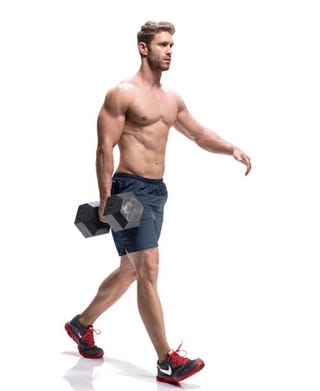
Trevor Reid
Suitcase Carry
Hold a weight—dumbbell, kettlebell, or an actual suitcase—on one side. Walk for the same distance or time with the other side loaded.
Front Loaded
These variations are especially taxing on your hamstrings and biceps.
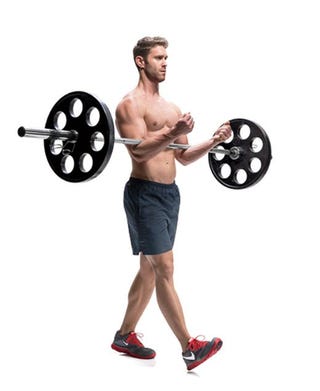
Trevor Reid
Zercher Walk
Hold a loaded barbell close to your chest in the crook of your elbows. Keep your core braced and your back straight throughout.
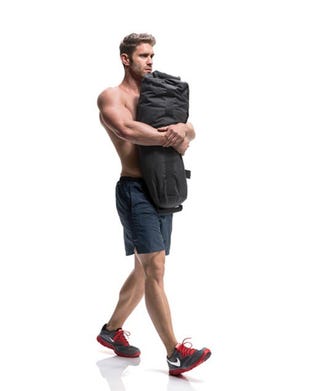
Trevor Reid
Bear Hug
Wrap both arms around a sandbag, weight plate, or large rock. Or hold a dumbbell or kettlebell just as you do for a goblet squat.
Overhead
Holding weight overhead challenges your core and builds shoulder stability.
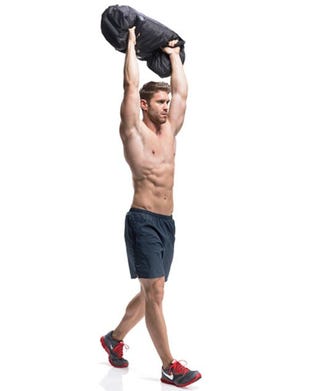
Trevor Reid
Overhead Walk
Hold one or two dumbbells or kettlebells (or a sandbag, barbell) directly over your shoulders.
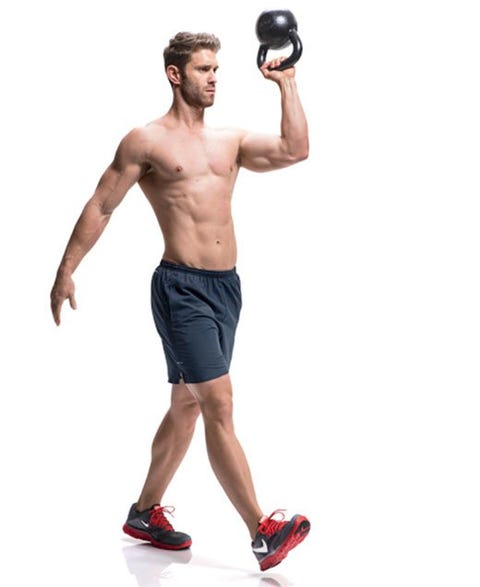
Trevor Reid
Bottoms Up
Hold a kettlebell upside down, your upper arm parallel to the floor and your elbow bent 90 degrees. Squeeze the handle tight.
That’s just the start. For some other carry ideas, checkout this video of 31 potential styles.
Stride Right When You Carry
There’s value in mixing up your distances and loads, says Davidson.
“In strongman training, we might carry something ridiculously heavy for just 15 yards, which is a killer test of raw strength,” he says. “Or we might have to carry something relatively light for a longer distance, which challenges strength endurance.”
Train different fitness skills by using the rough guide below when you do the farmer’s walk, suitcase carry, Zercher walk, and bear hug walk. The percentage of body weight equals the total load you should work up to carrying for the distance.
Carry 100 percent of your bodyweight 50 feet to build more strength. Go long and heavy by carring 75 percent of your body weight 150 feet. Finally, challenge your endurance and carry 50 percent of your bodyweight 300 feet.
Source: Read Full Article






